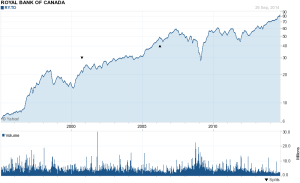A recent post on Facebook about the integrity of the financial system being out of control reminded me of that old ditty that included the phrase “trying to make a dollar out of 15 cents”. I won’t repeat it here because it has a racist component but the idea of making a dollar out of 15 cents is an interesting one……and more or less possible in the current financial system. This post will describe how a dollar is made out of 40 cents without producing any real value…..it is simply about making the numbers work in the current financial system.
There is a mutual fund company in Canada which has a number of individual funds, some of which invest only in big solid banks. Here is the “magic” that they produce. Most of these banks they invest in produce just under 4% in annual dividends. Yet this fund is able to pay you around 10% annually. A Ponzi scheme? On the surface, it would appear so, after all how can you take in 4% and pay out 10% without paying back out of the original capital? Well, it can be done legally and it is possible that the fund will actually grow, not shrink as it pays out the annual 10%.
Since there are a number of complexities involved in these funds, I will explain how it works by a simplifying example assuming that the fund has only one stock in its portfolio and show how they get the returns up to 10% annually from a 4% annual income. It’s all perfectly legal, is done everyday in the financial system but one has to wonder about the morality of making money like this without producing one thing of value to anyone.
Let’s assume this fund has $100 worth of shares from one bank that pays a dividend of $4/year. Here is how they are able to pay you $10/year out of that:
1. Dividend income
This is the most obvious as the bank will make quarterly payments of $1/quarter for a total of $4/year.
2. Margining
This idea allows the investor (your fund managers), to buy shares on margin, which is effectively meaning they borrow the money for it. The bank your fund deals with offers very low interest rates when you add shares because they are fully backed by your original $100. In today’s environment, a bank can get money for 1% and will loan it out to top clients for as little as 2% (3% at most which is the prime rate right now). So if you margin the stocks at a cost of 2%, you will have $200 worth in your account, generating an extra 2% (4% dividends – 2% interest expense = 2% extra revenue). So with that technique, the fund is now earning as much as 6% annually.
3. Selling covered calls
This is a more complicated technique with stock options (see one of my previous articles on it https://mindmuser.wordpress.com/2014/08/23/313/?preview=true&preview_id=313&preview_nonce=429de4aa9a&post_format=standard), and because the big banks are so stable, selling covered calls don’t earn as much as less stable companies but nevertheless, this fund will be able to earn 1% on certain months, so it would be fairly easy for a good manager to increase the return by 4-6%/year with this. That raises the returns to 10%/year or more.
4. Capital appreciation
Because of the importance of the stability of big banks to the government (not to mention the tax revenue they generate), governments will do everything they can to make sure that banks are prosperous and grow every year while the public pays through the nose for their services. So they grow in share price too. The Royal Bank of Canada increases in share price by well over 10%/year alone over both short and long term averages. These funds just need to hang onto the stock and they can practically meet their payout from capital appreciation alone.
Here is a chart for the Royal Bank stock price over almost 20 years:
So there it is. You can make 10%/year by investing in a company that pays out 4%/year and you are doing nothing to earn it except by applying some math skills to the numbers. Legal? Yes. Sustainable? Yes (but not guaranteed). Moral? That’s worth another discussion!
